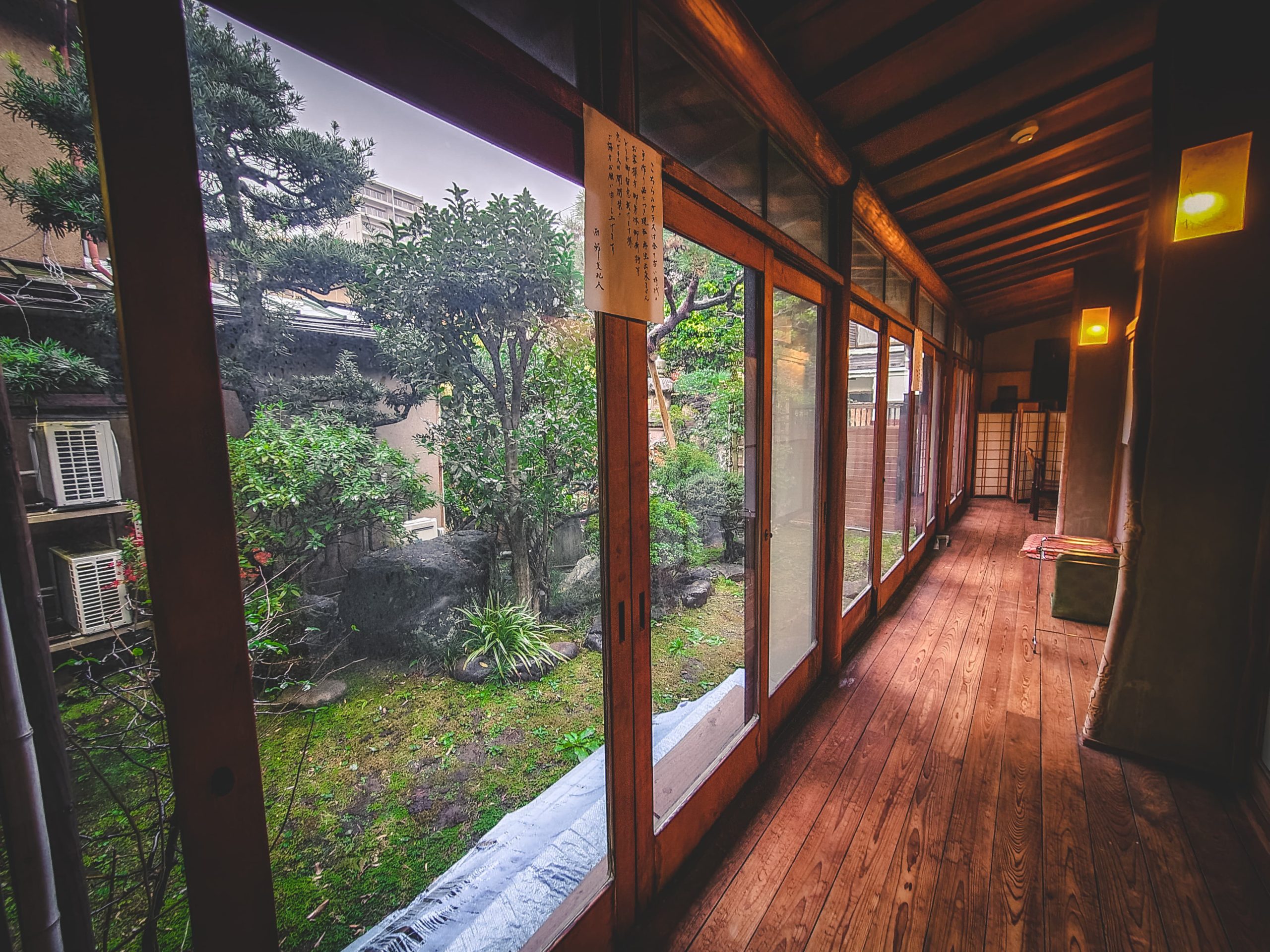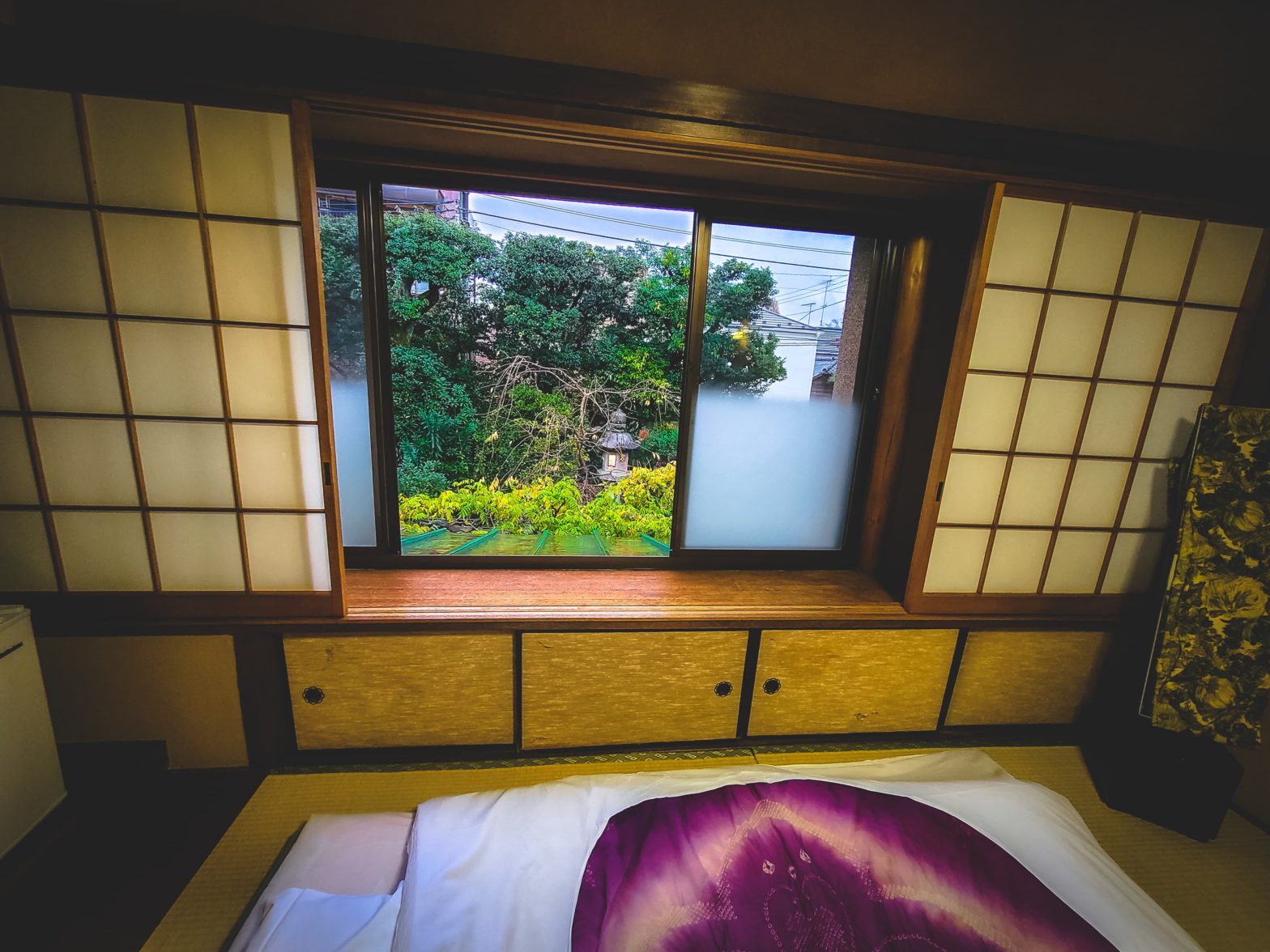It’s my favorite time of the year and the weather beckons for a stroll outside, which is perfect because my destination is a quick 7-minute walk from the station. Okigubo, on the western outskirts of Tokyo, is a busy area. Although it is a few stops removed from Shinjuku, it still very much retains the same kind of energetic bustling city-feel with its drug stores and various shops.
As I near the area of the ryokan, I notice that the noise of the city has disappeared and suddenly find myself in a quiet residential neighborhood.
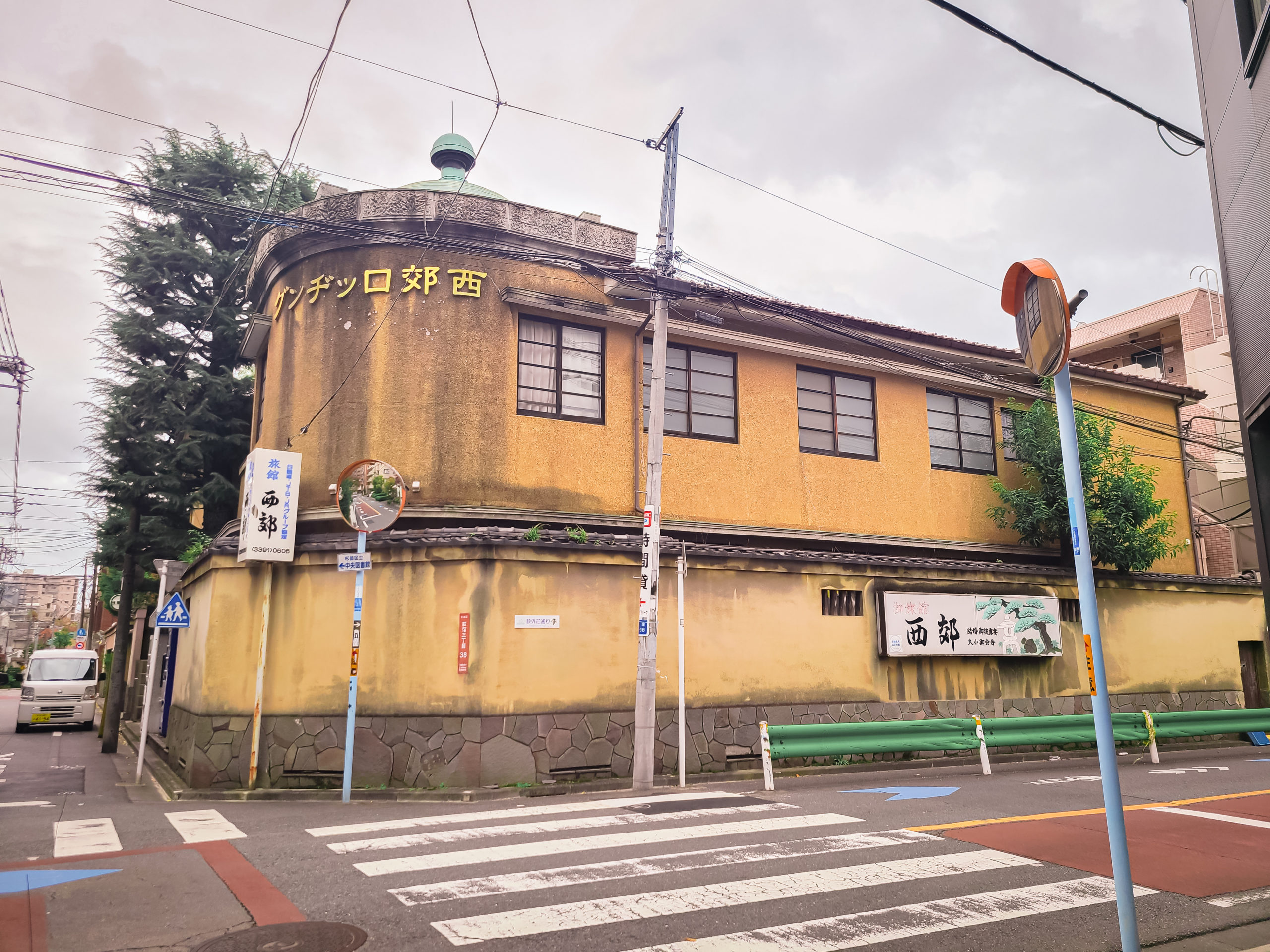
I look ahead to see a unique looking building with a sign displaying the same name as my destination, Ryokan Seikou. A quick look around the corner to search for the entrance to the ryokan, brings me to a surprising realization: the building takes up practically the whole block.
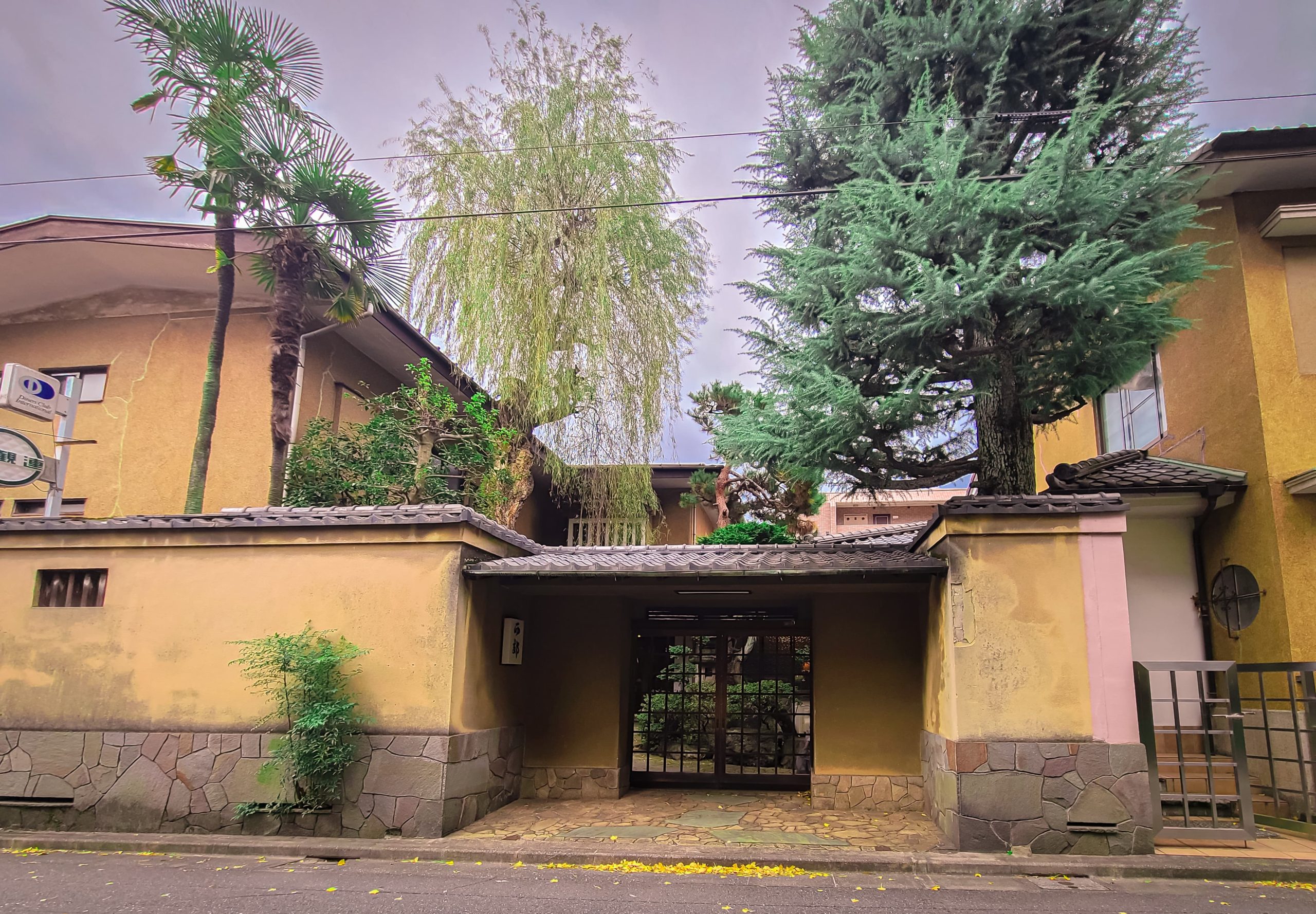
Finally, I find a traditional-looking entrance, the tile-roofed gate leading me through a small garden with an almighty willow tree, a stone lantern, and a picturesque pine tree which looks as if every curve in its majestic body has been carefully calculated and preened in the most perfect, yet natural flow.
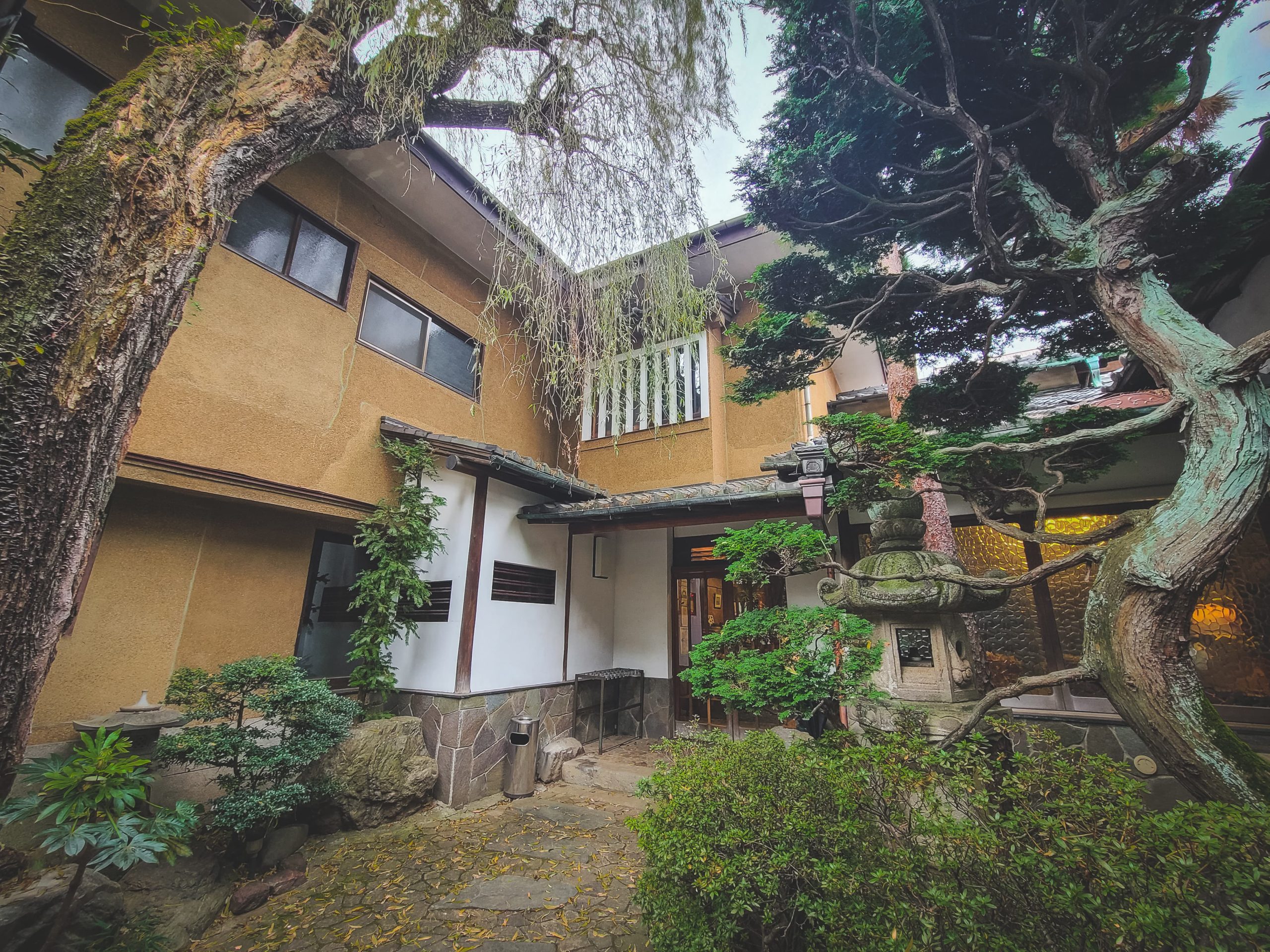
I enter the genkan through the wood and glass sliding door. One quick look and I think to myself that perhaps I have just stepped through the looking glass.
Time has stopped here. Everything I lay my eyes on, from the flooring and ceiling to the furniture brings about a strong wave of nostalgia.
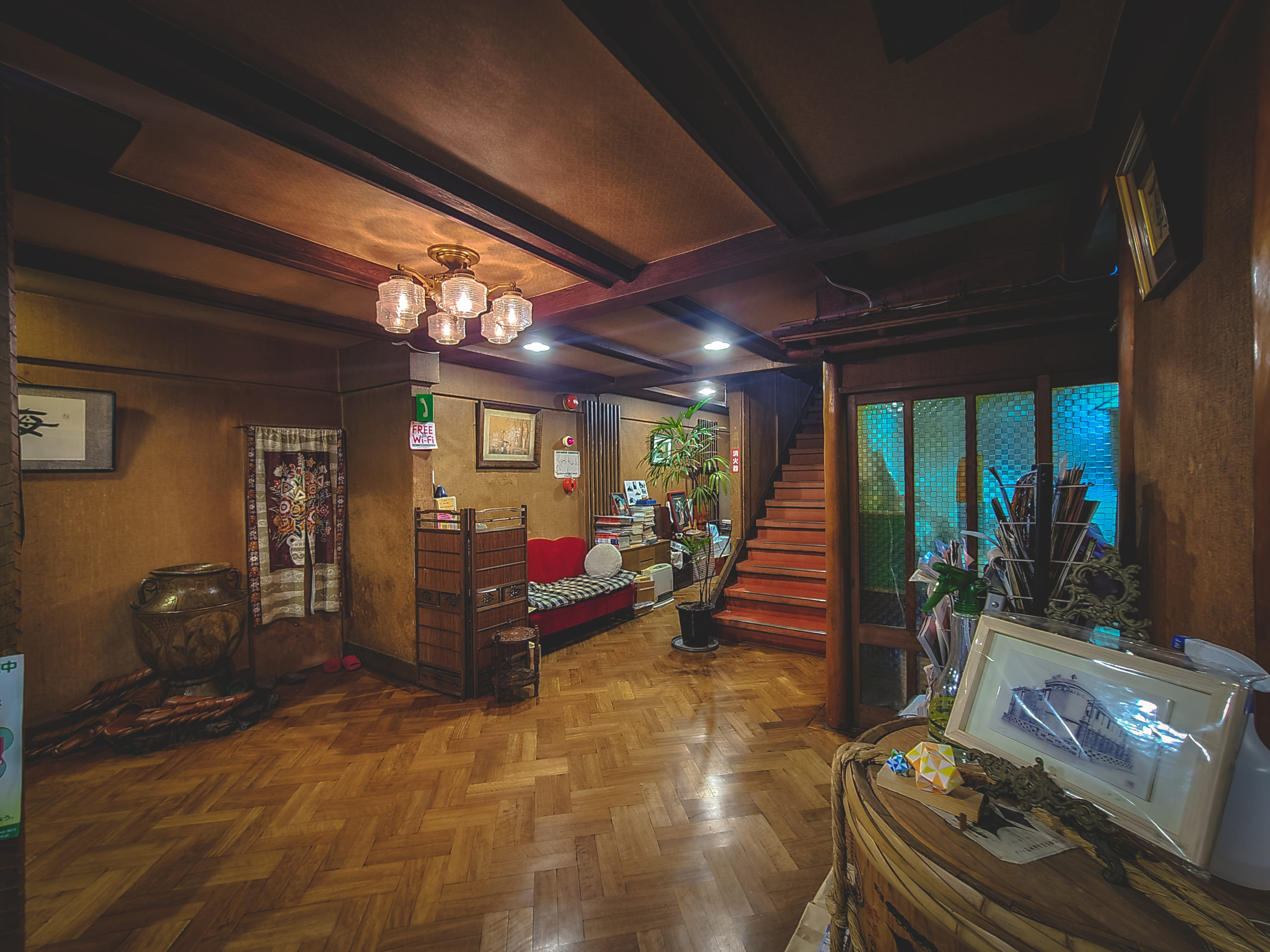
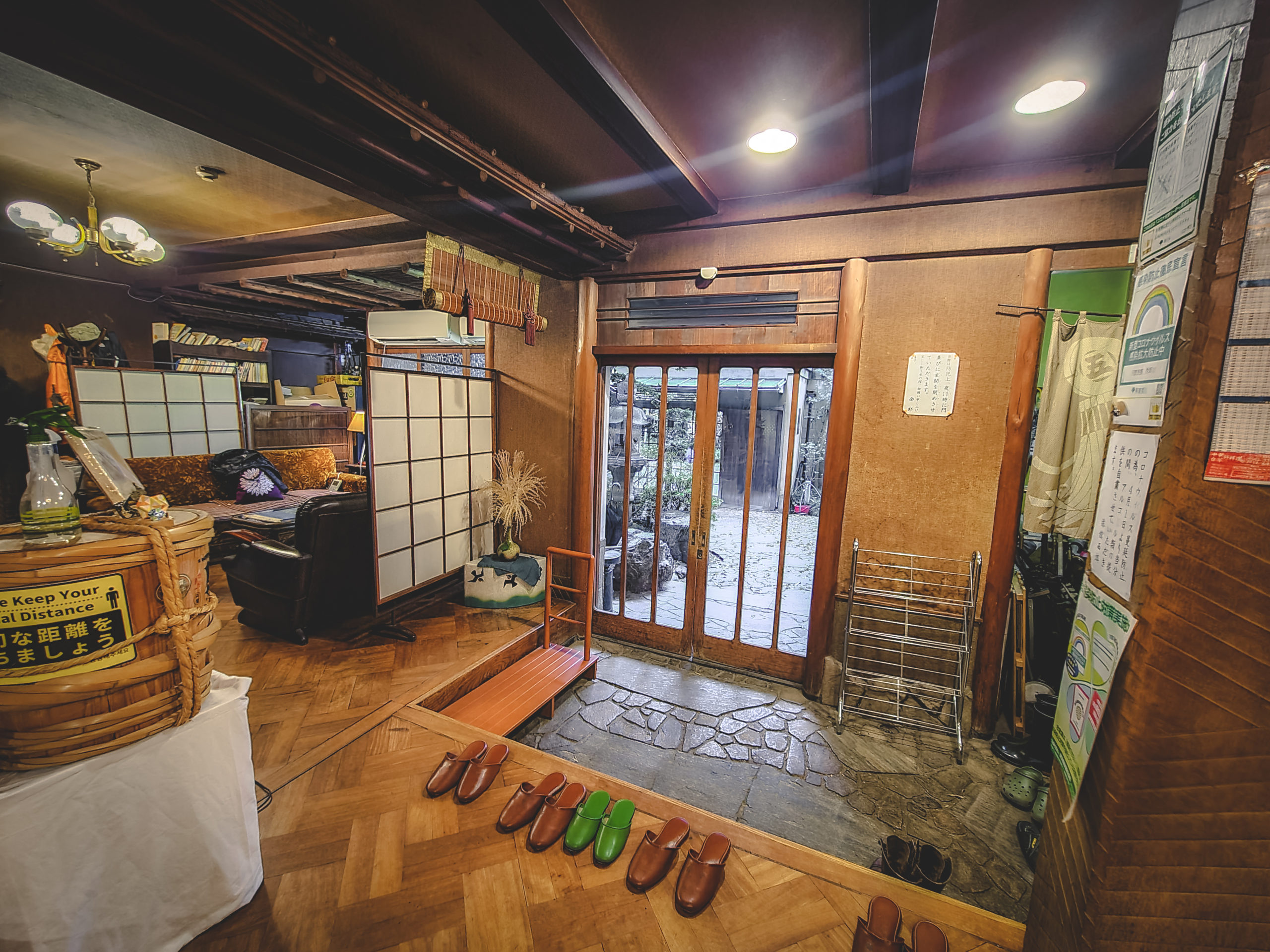
Seikou is run by Hirama-san and his wife. Hirama-san leads me to a small waiting space next to the genkan entrance. The couches are vintage pieces, featuring velvet colors and textures that can no longer be found in modern furniture. Even the glass of the window that looks out into the garden is decades old.
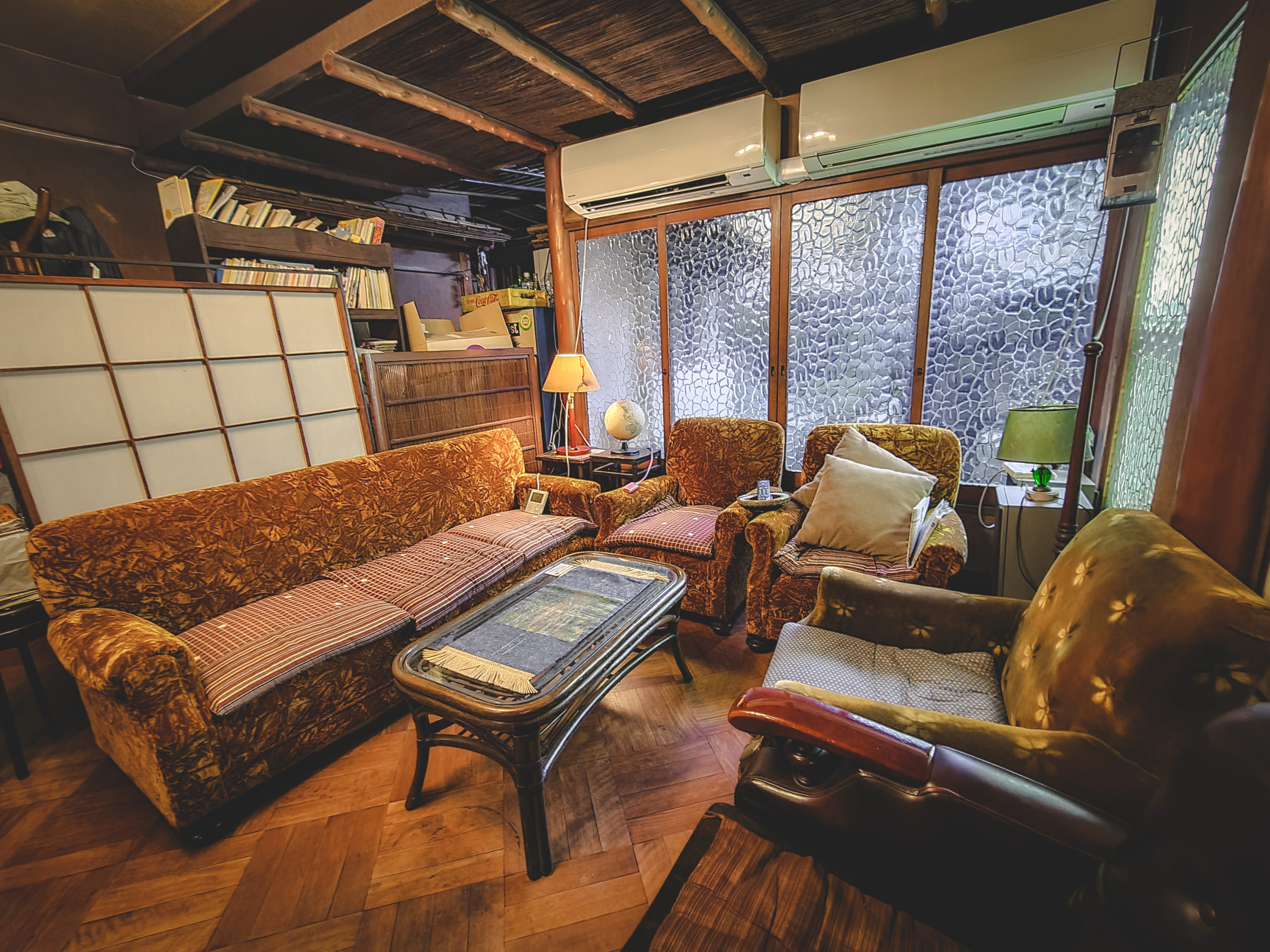
The couple sits down in front of me and Hirama-san’s wife doesn’t miss a beat before starting their story.
“This fireplace is a remnant of the way this place originally looked; it was one of the first lodgings that was designed in western style. This place was originally called Seikou Lodging, and at the time, every room had a fireplace-style alcove with a heater in it,” she begins.
Founded in 1930, Seikou Lodging was originally used for long-term stays. Back then, the area was considered the be the western edge of Tokyo, and the inn was aptly named as such, Seikou meaning “western outskirts.” While Ogikubo station did exist already, the area around it was vastly different compared to what we see today, mostly populated by vacation houses.
The inn was opened by Hirama-san’s grandfather, whose work took him in and out of the imperial court. There, he was exposed to the gaining popularity of western-style items imported into Japan at the time. He fell in love with the aesthetic and decided to build his own ryokan in a completely western style, which was very uncommon at the time.
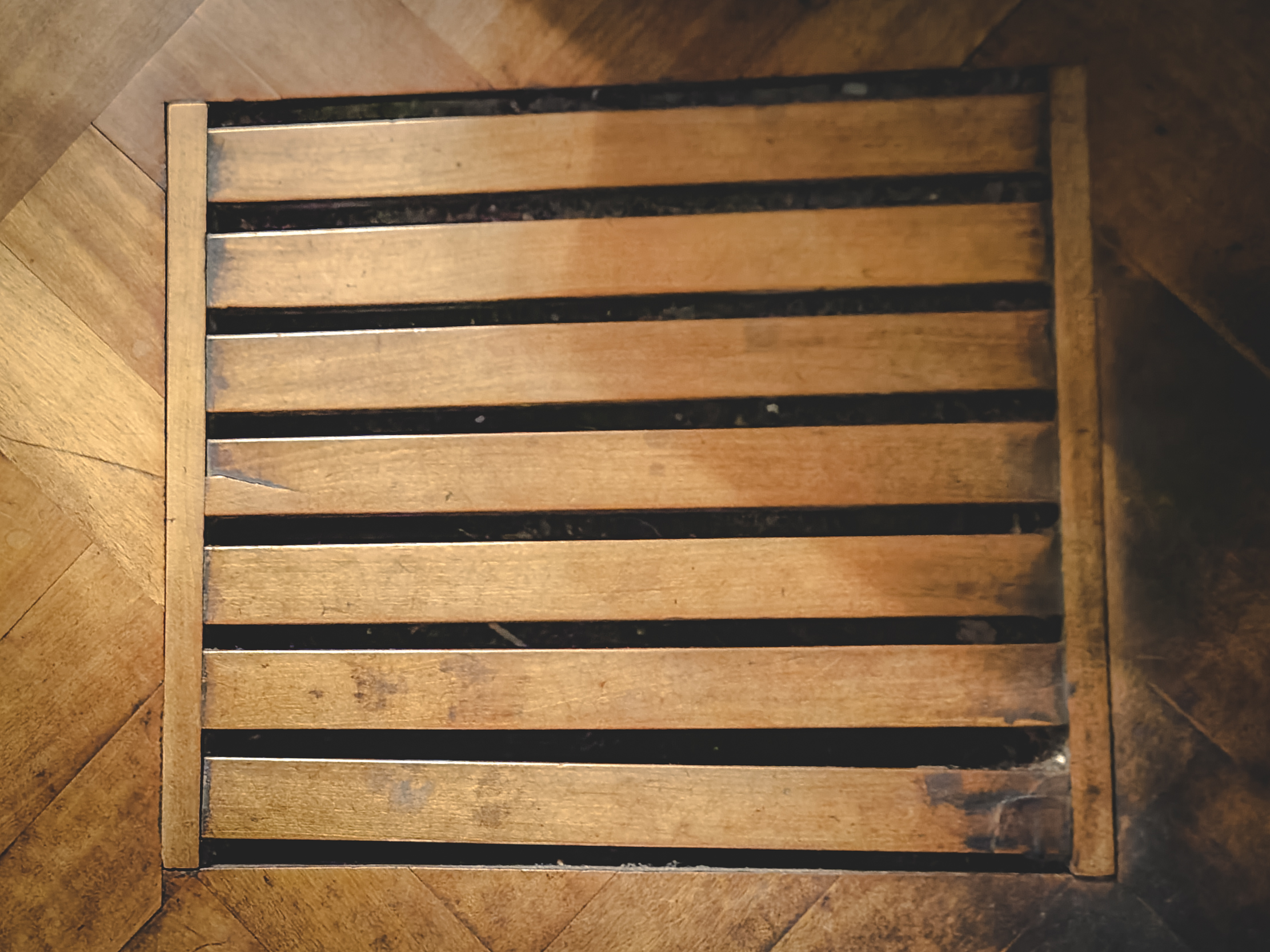
Now running the ryokan for over 50 years, Hirama-san began helping out with the ryokan at a very young age. His father was a veterinarian, a practice that required constant travel, and so he was unable to take over the family business. As such, Hirama-san became the natural choice to inherit the place from his doting grandparents. Young and able, Hirama-san did much of the managerial work that came with a lodging that catered mostly to businesses—the handling of paperwork, invoices, and accounting.
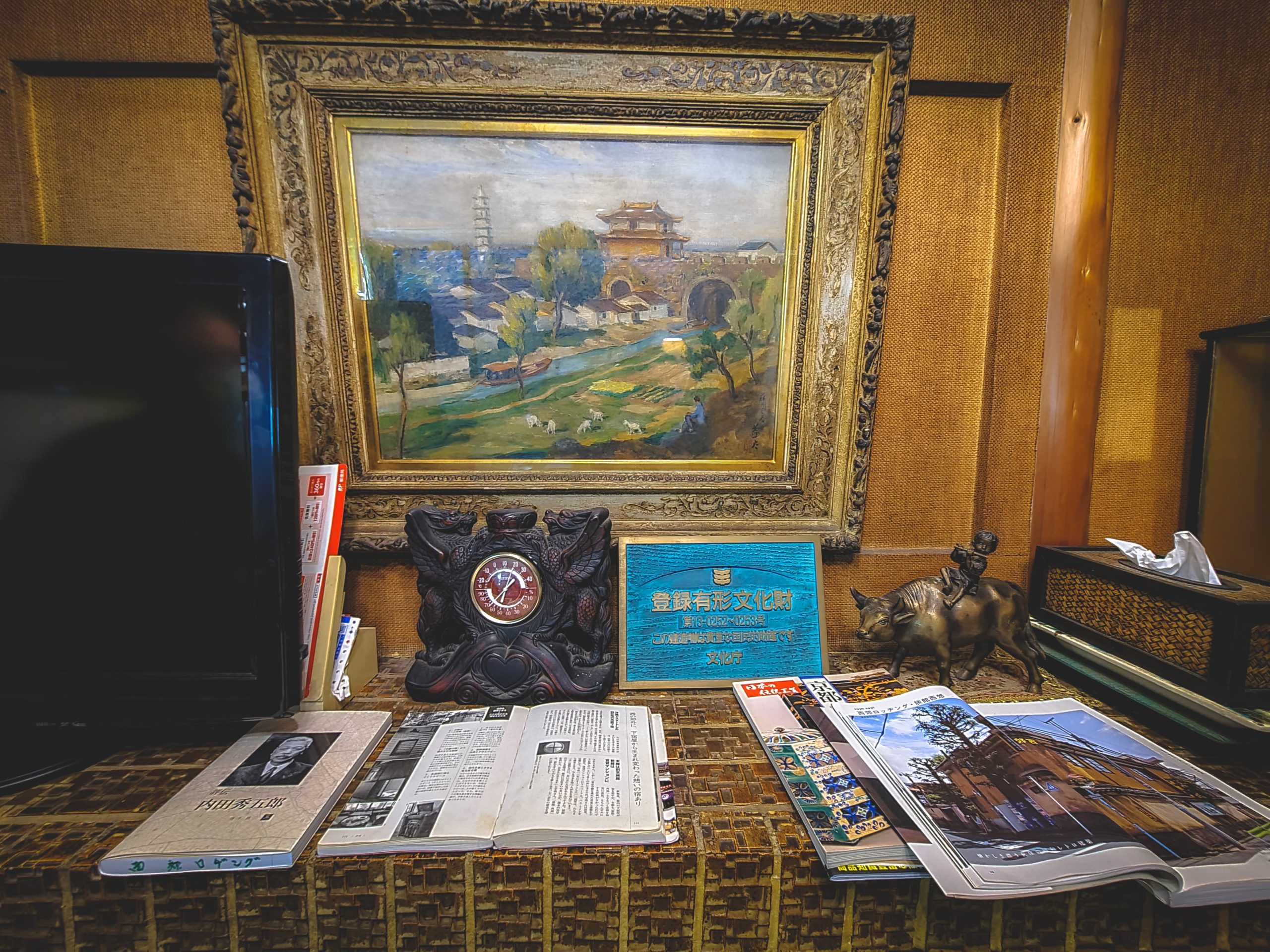
Gradually, business stays turned into vacation stays, and after the war, the western style interior was renovated into Japanese style. A portion of the property (the first corner of the building that I encountered on my way here) was turned into an apartment complex, but the spirit and air of its heyday remains untouched, it’s the inn’s living pulse felt through the materials used for the interior to the furniture. More than just a lodging, nowadays it is the main attraction—Ryokan Seikou is registered as a tangible cultural property and a must-see destination for people who have an appreciation for architecture.
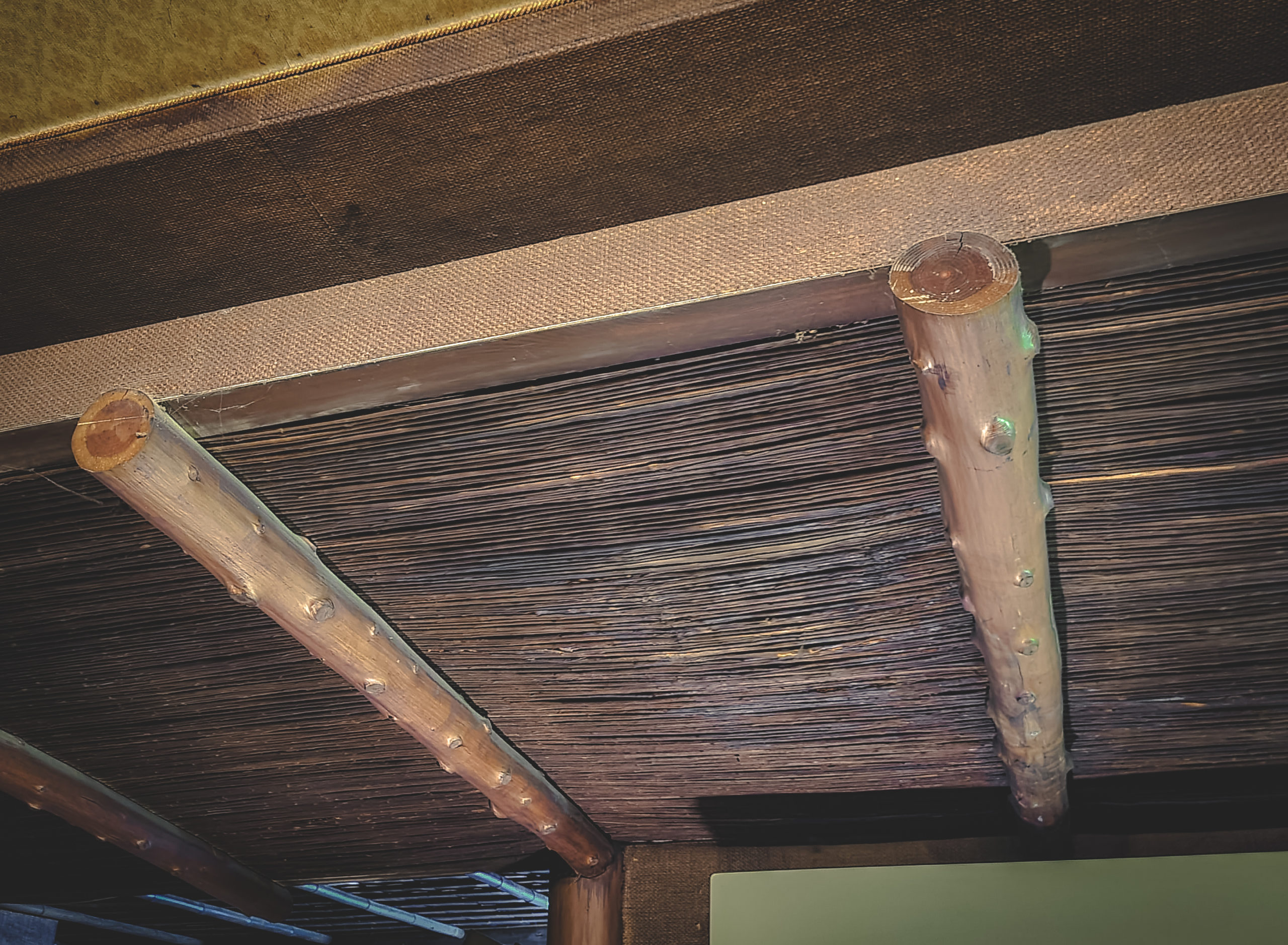
I ask for a tour of the two-story building, and the couple begins by first leading me to one of the still actively-used enkai rooms (a Japanese-style room reserved for parties and gatherings).
Moving through the halls I notice that all the walls are traditional tsuchi-kabe, clay walls that are fragile and extremely time-consuming to make. While the lobby itself was obvious proof that this was no ordinary ryokan, the first few steps prove to show that I’m not at all prepared for what I’m about to see.
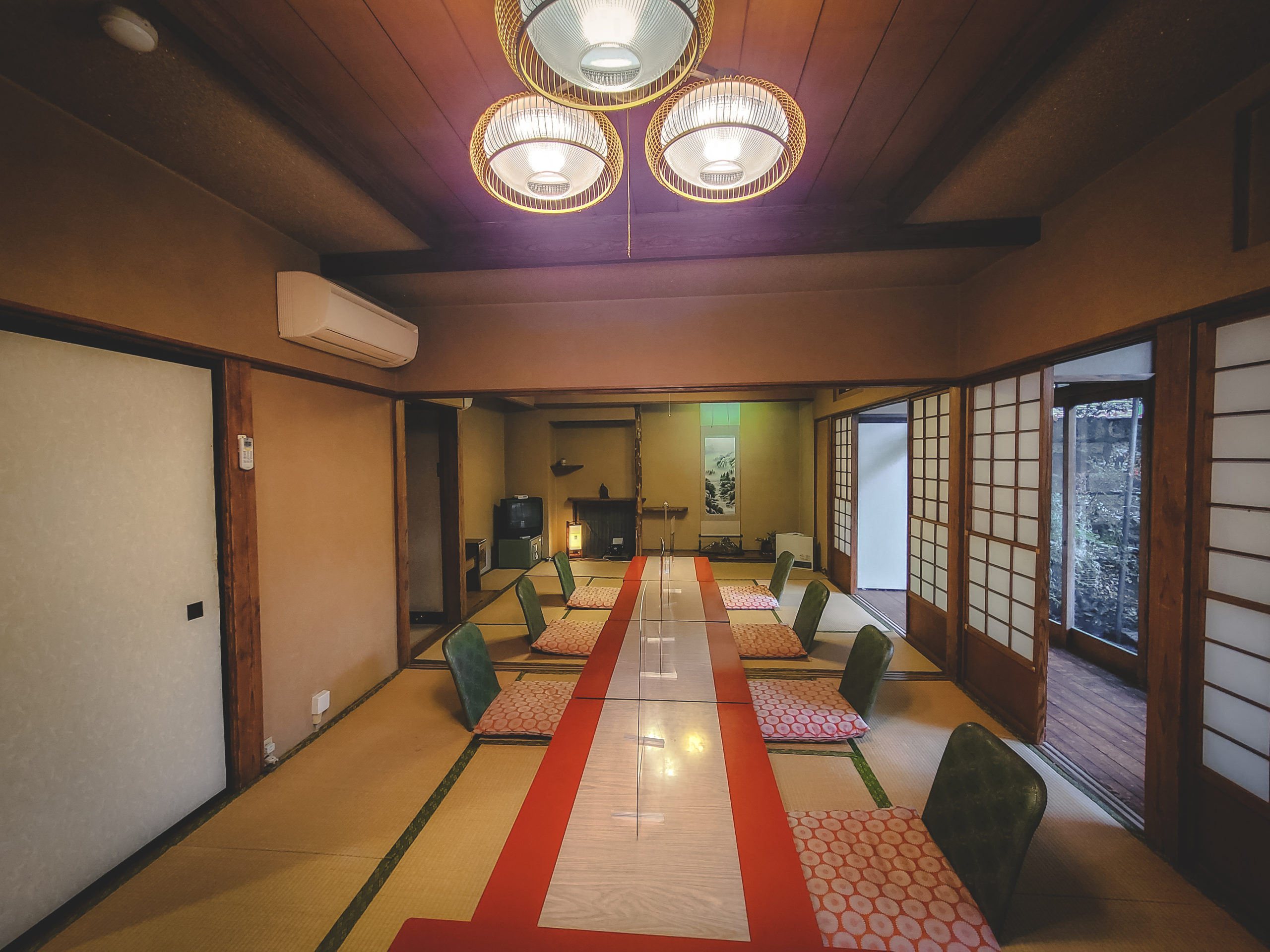
The enkai room is vast and even has its own engawa, an open corridor that’s usually found facing the inner courtyard of traditional Japanese houses. I step closer to look beyond the sliding shoji doors, only to have my breath literally taken away.
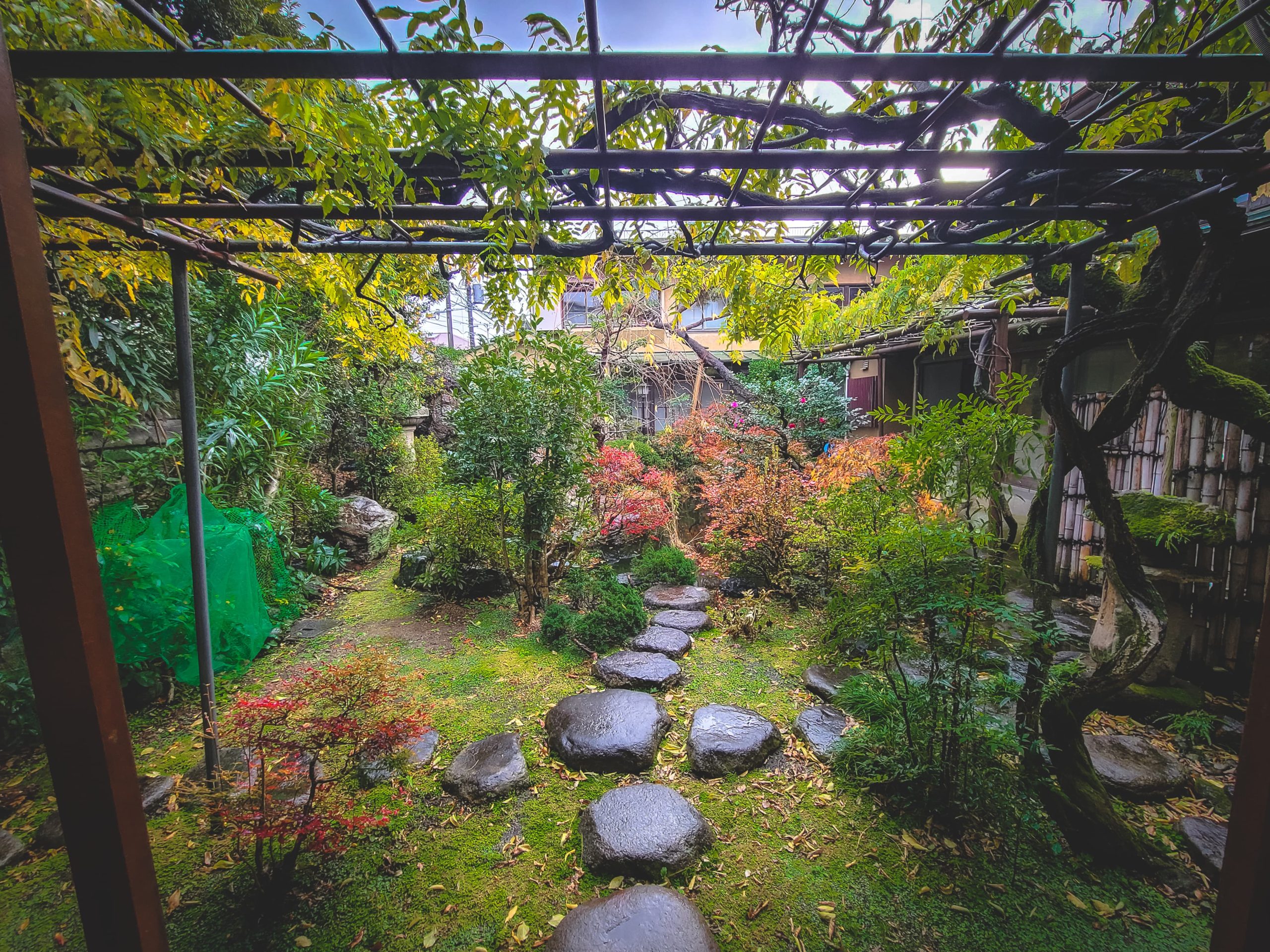
The whole side of the enkai room faces a nakaniwa, an inner courtyard garden, that can only be described as nothing short of magical. I stand for a few moments in awe, as neither my camera nor my words can possibly do justice to explain the wonder of the sight I see in front of my eyes.
The garden is dense, and again just like the pine tree outside the entrance, all the foliage is carefully preened and shaped into a completely balanced and harmonious smorgasbord for the eyes.
Right outside the engawa is a wisteria trellis, set to bloom in May. The stepping stones wet with the lightly-falling rain lead to a small pond, while a medium-sized shidare-zakura, weeping cherry tree stands waiting for its time to shine a few months from now. For now, the spotlight remains on the changing autumnal leaves and the camelia bush in the back.
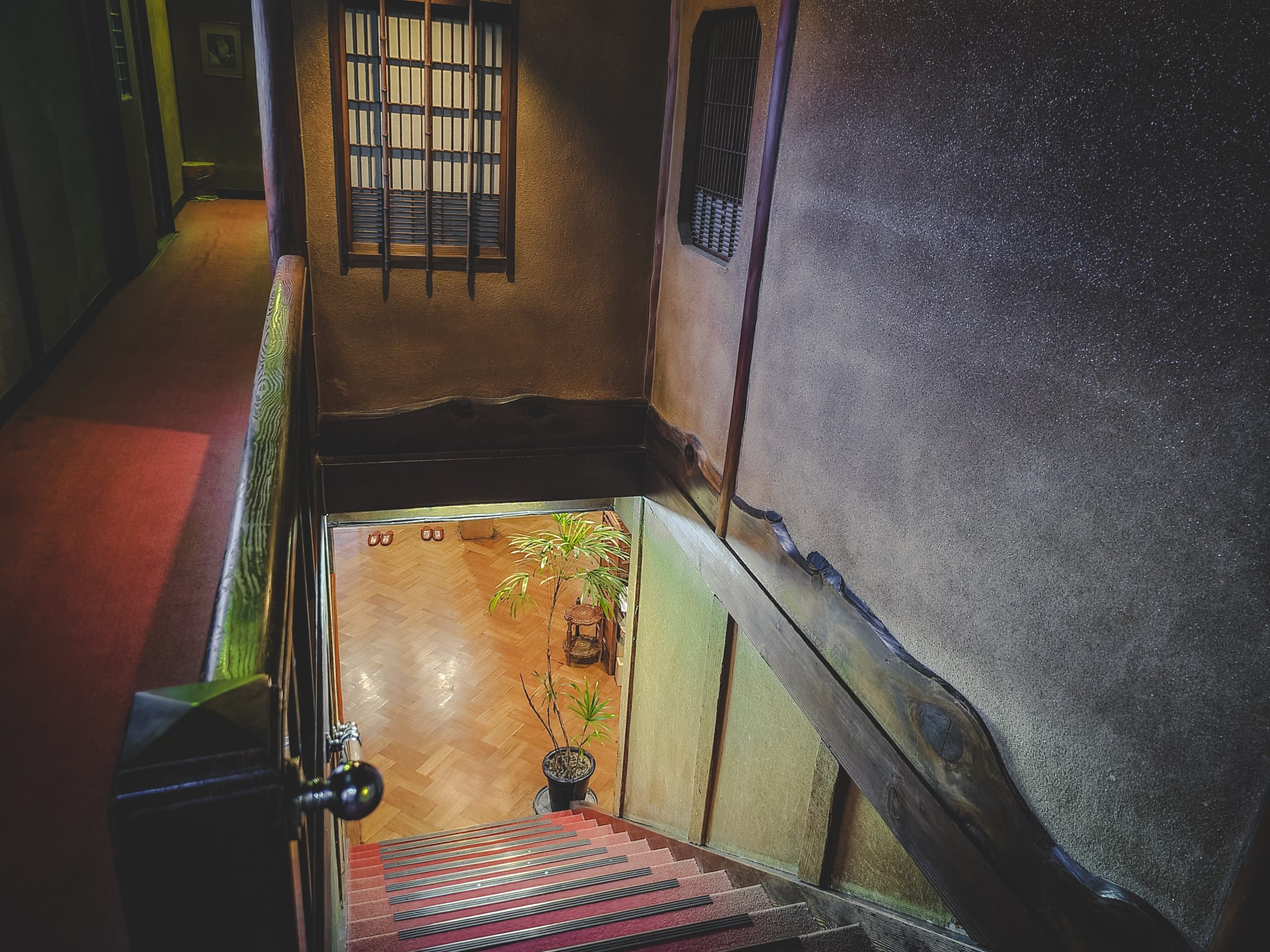
It’s no surprise that the enkai room plays host to regular gatherings of haiku poetry—writing poetry seems to be the only logical conclusion when presented with beauty such as this.
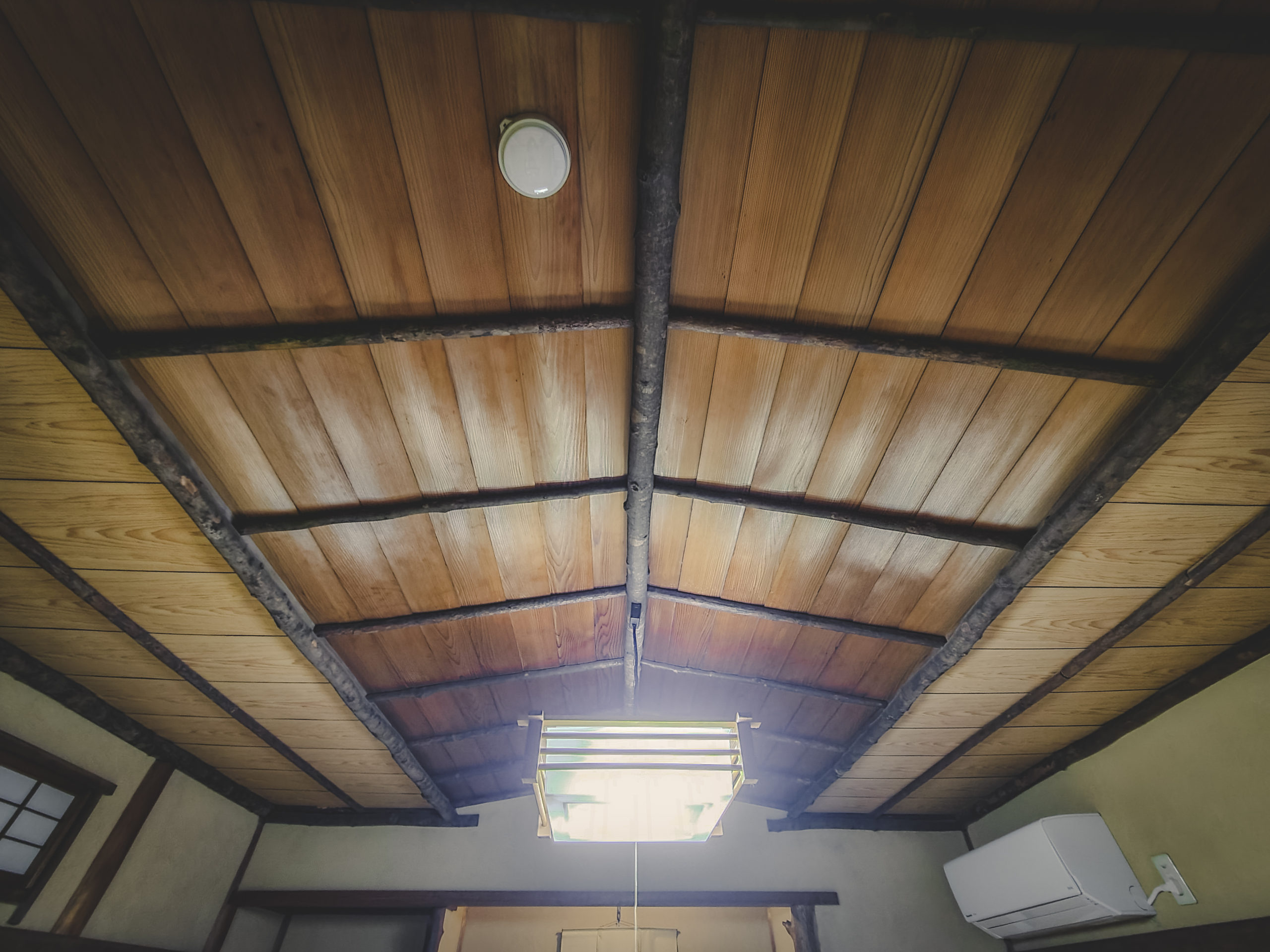
I feel as if I could stay in this room forever, and it still wouldn’t be long enough. Alas, I have still yet to see the actual guest-rooms of the inn, and I ask Hirama-san to guide me through the rest of the building.
While the ryokan has a total of 12 rooms, as a preventative measure against Covid-19 only alternating rooms are being booked, which means half the number of guests.
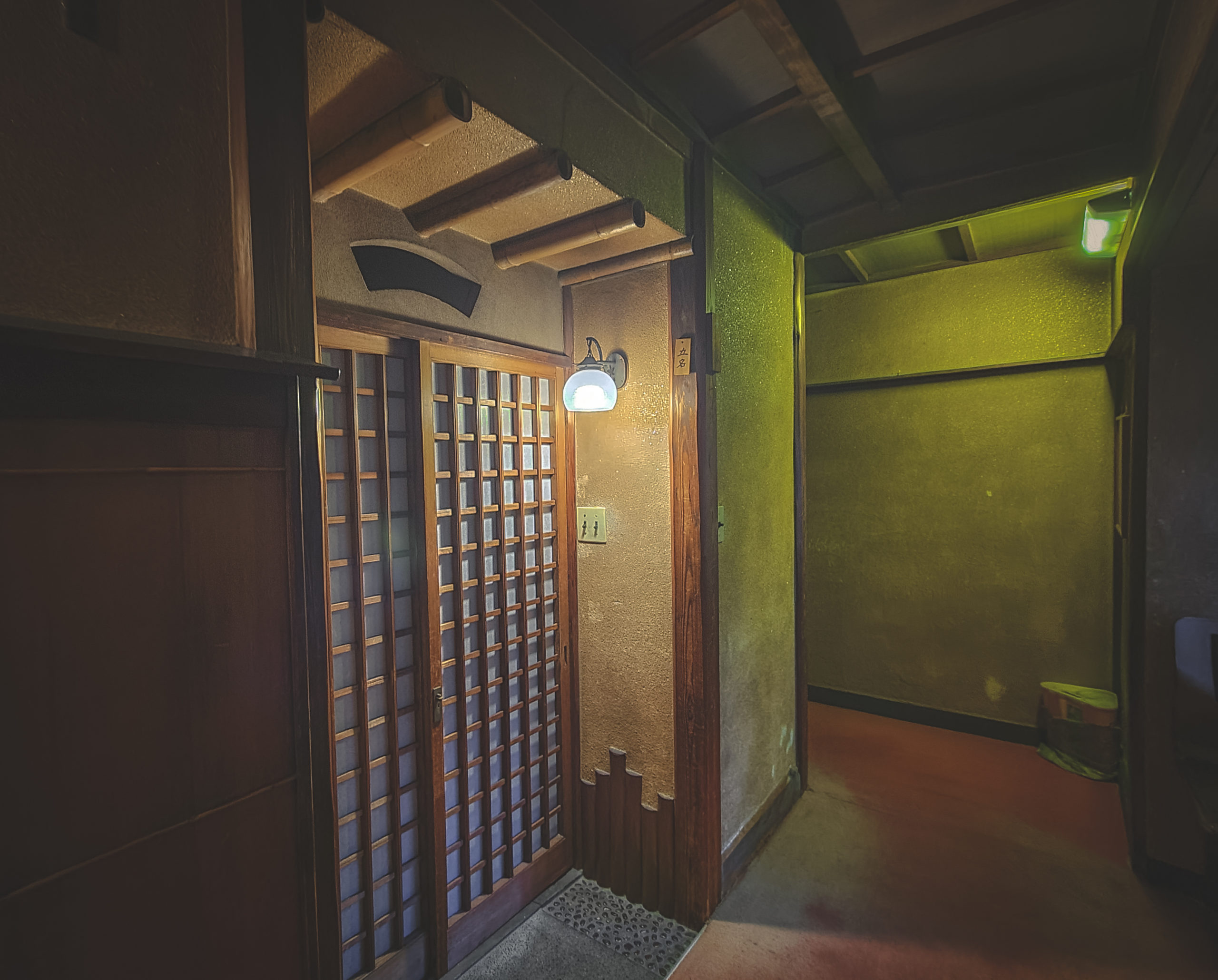
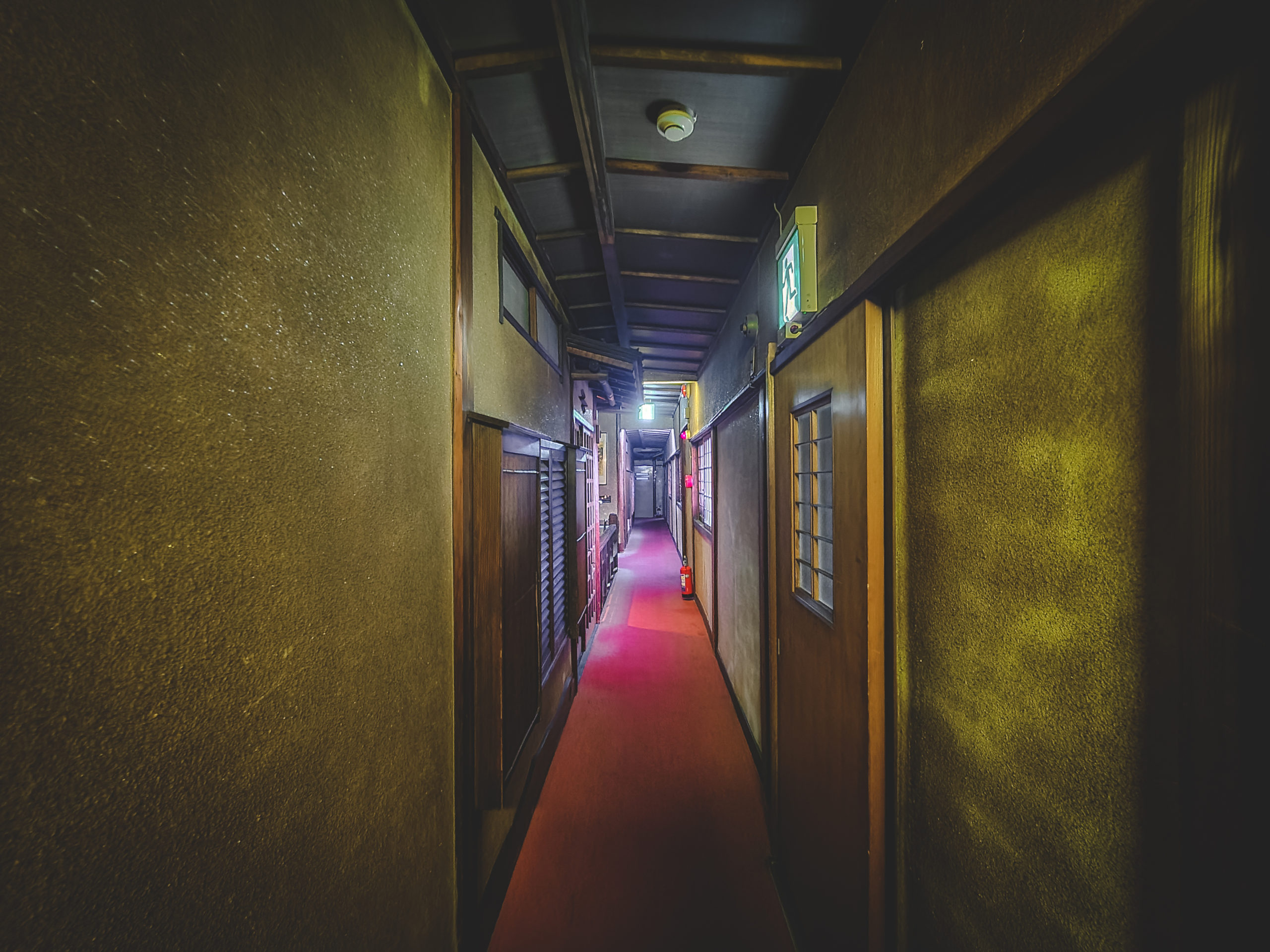
This ryokan is rightfully a treasure trove of architectural wonder. As the couple leads me through the hallways on the second floor where the guest rooms are situated, Hirama-san’s wife mentions that the interior is quite unique in that its design resembles more that of a ryotei, a high-class traditional Japanese restaurant, rather than a ryokan. This is apparent in the use of roof-type structures for each room and throughout the building.
I even spot cedar bark thatched roof, a rare technique nowadays usually only seen in high-end tea room architecture.
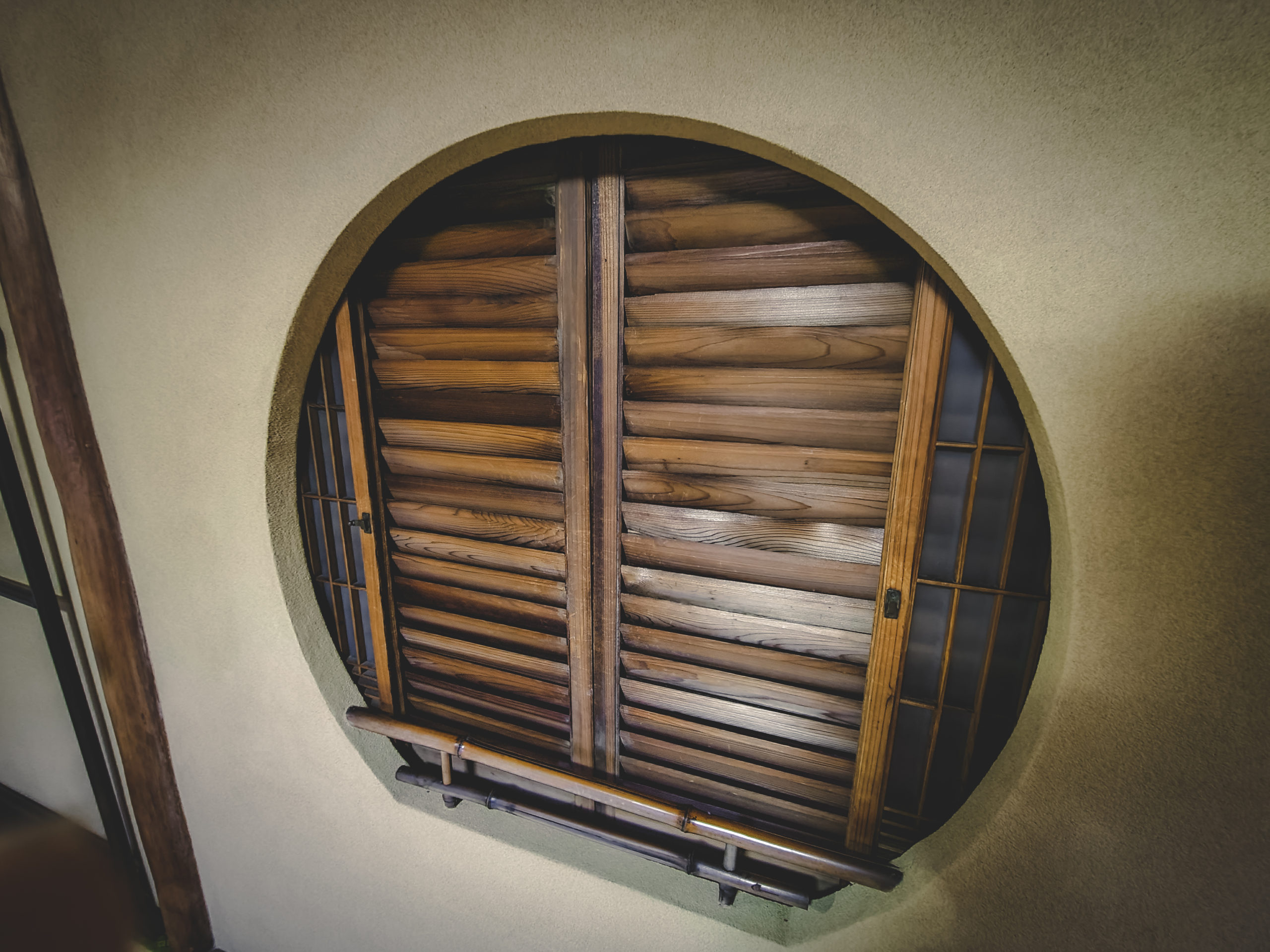
It seems the head carpenter who designed this place also enjoyed adding interesting details, that while not necessarily practical for a ryokan (for example a round window that opens out into the hallway, complete with “privacy shades”), nevertheless provide an amusement park for anyone who enjoys various architecture and carpentry techniques.
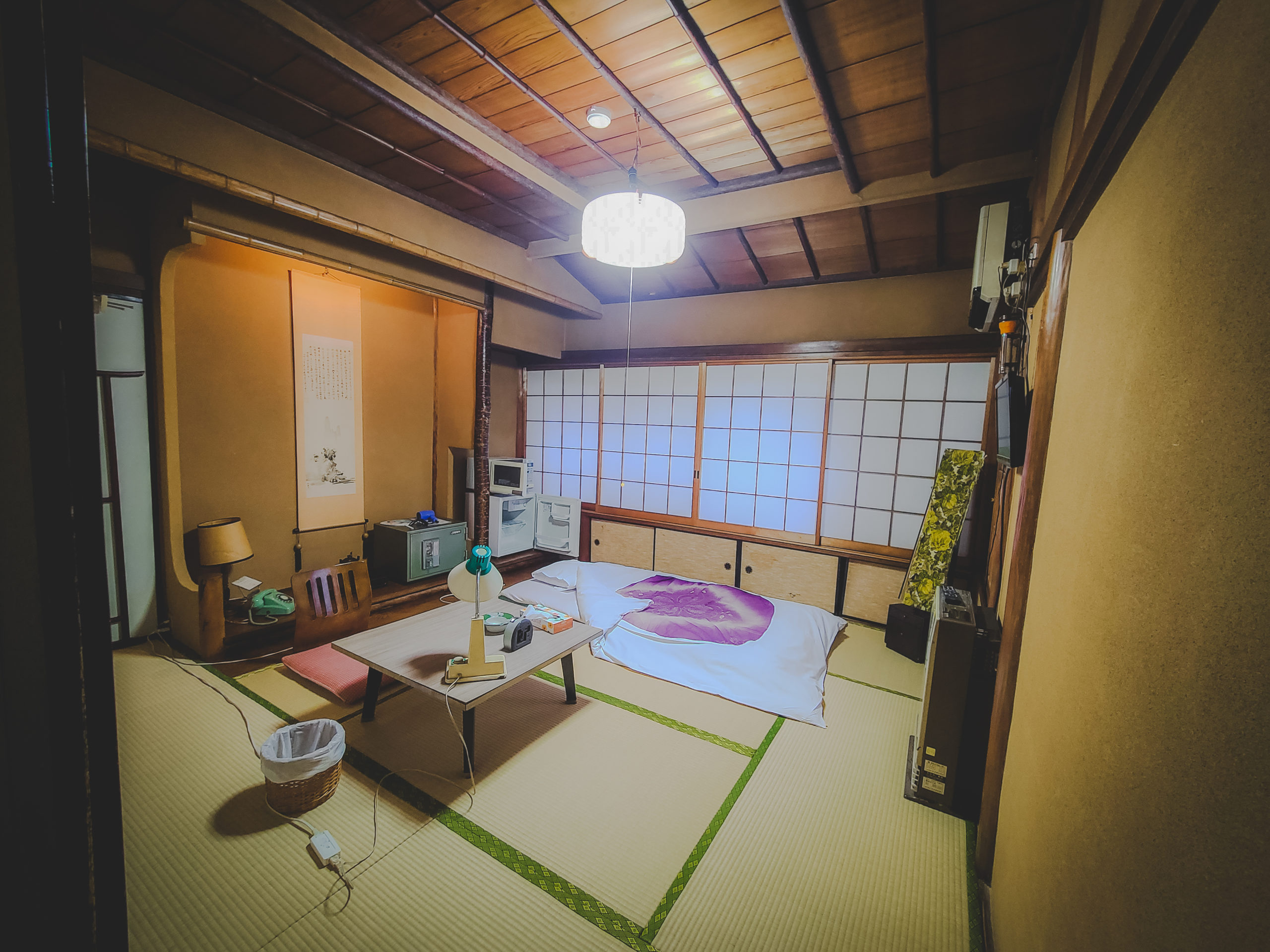
Inside the ryokan you can find practically any and every technique used by traditional Japanese carpenters, miya-daiku.
Quite unusual for an inn, some of the rooms also have a stone entrance. All aspects of the rooms, from the ceiling style to the daikokubashira post that stands at the side of the tokonoma alcove, vary from room to room, allowing no chance for boredom.
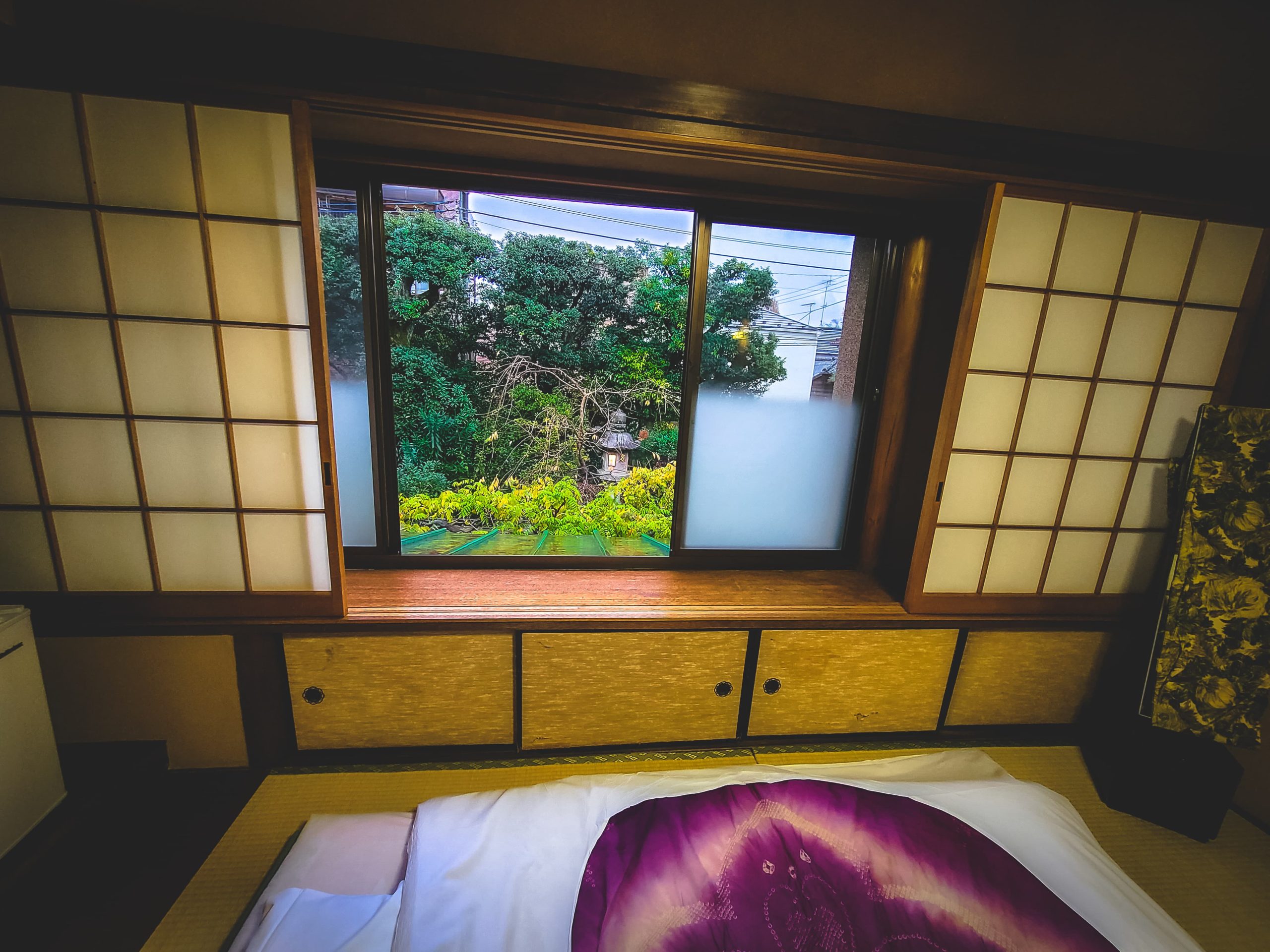
The view from the window also provides a pleasant peek into the nakaniwa garden. As I take a look outside, I notice that the stone lantern standing beside the Sakura tree has been lit to signal the coming of dusk.
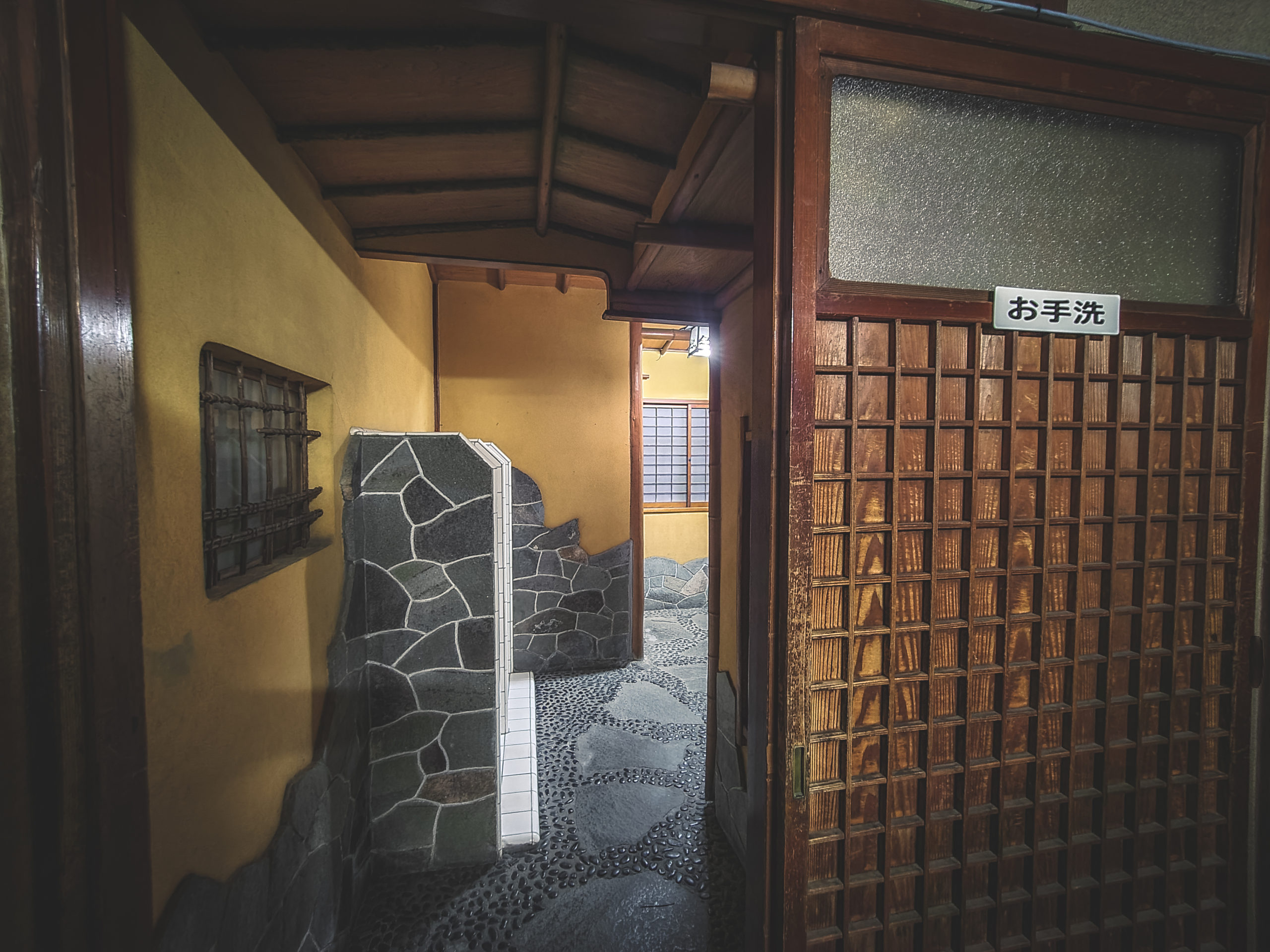
As a last pitstop before I come to the end of my visit, the couple takes me to the first-floor bathroom, which has been used as a set for movie shoots as one of the few remaining authentic Showa-period style bathrooms.
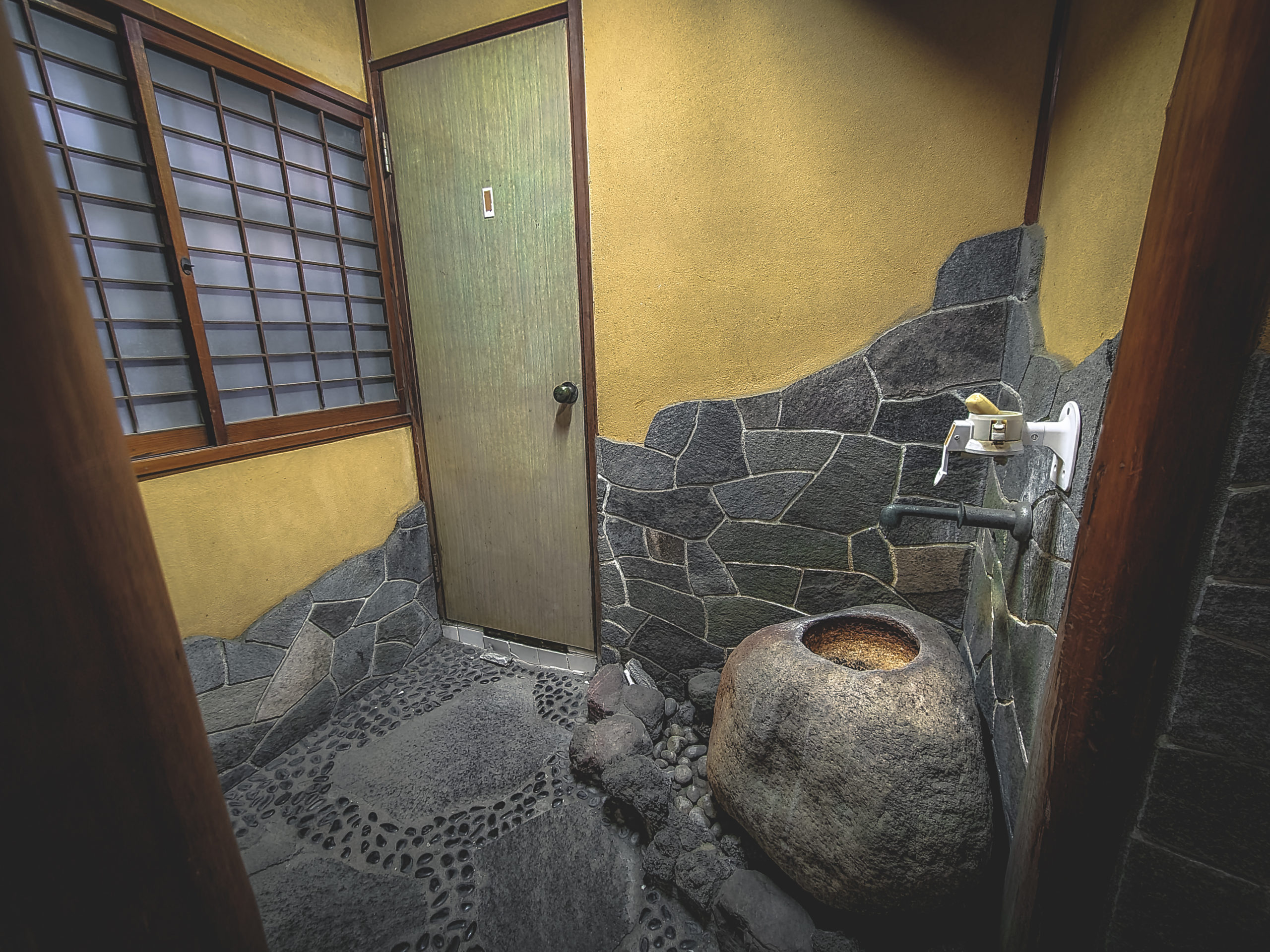

Completely covered in tile, it features two Japanese-style toilets. I am truly impressed at the level of detail that has been imbued into the place, from the stone floor to the walls, and most interestingly, the faucet that is situated above a tsukubai, a stone wash basin.
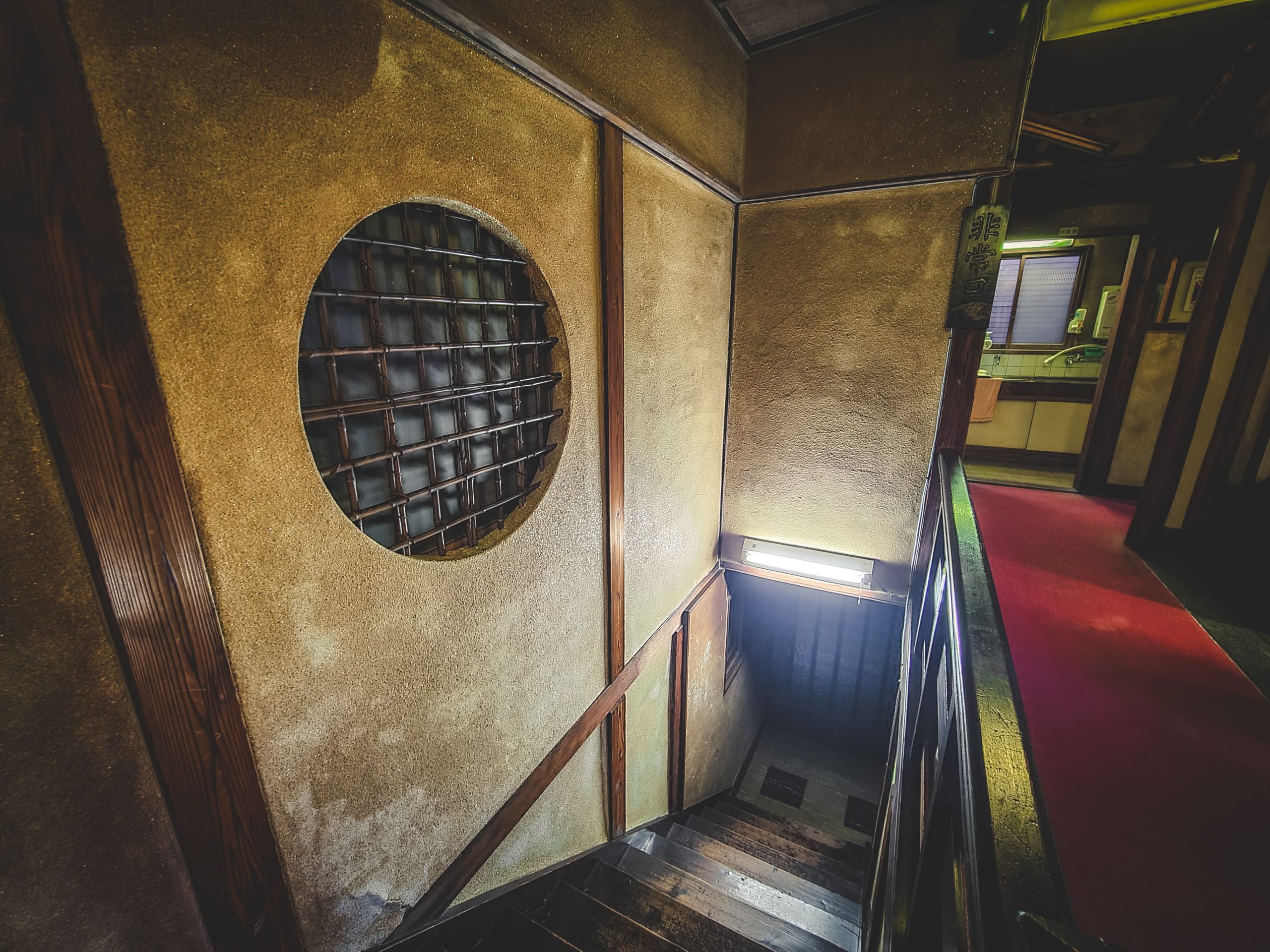
While everything about the ryokan feels like it’s from a different time, rest assured, it still has modern conveniences like free Wi-Fi and a small refrigerator in each room.
If you want some time to get away from the here and now, focus on some writing and compose a poem or two, taking refuge in this parallel dimension of Ryokan Seikou may be just what the doctor ordered. My only piece of advice is, if you do stay here, allow plenty of time to appreciate this place for what it is: a timeless treasure.
